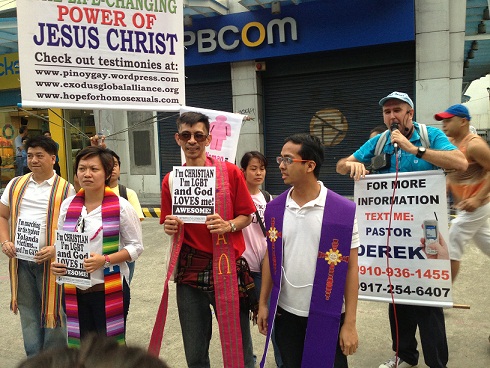Text and photos by PATRICK KING PASCUAL
JUST as loud as the colors of the banners they waved, were their impassioned chants of “Walang masama, walang masama, walang masama sa pagiging bakla!(There is nothing wrong with being gay!)”
The 2013 Metro Manila Pride Celebration, held in Malate last December 7, attended by about a thousand showed that they gay community in the Philippines has come a long way in their struggle for the most basic in a democracy: equality.
“It’s important for the LGBT community to celebrate Pride, because this is an event that highlights the successes and the challenges the community has achieved in the past year,” Michael David Tan, founder of Outrage Magazine, the only LGBT magazine in the Philippines and Bahaghari Center for LGBT Research, Education and Advocacy.
LGBT stands for Lesbian, Gay, Bi-sexual and Transgender.
With the theme, “Strength in Colors”, Tan said this year’s Pride March “is a reminder to everyone that we have achieved a lot to enjoy equal rights, at the same time, it’s still a reminder for the entire community, that there is still a lot to be done.”
The Pride March started in the United States 44 years ago in the United States to commemorate the spontaneous protest on June 28, 1969 over the police raid of Stonewall Inn, a gay bar in Greenwich Village in New York.
The organisers said the Pride March would be an annual reminder for the gay community “to be more relevant, reach a greater number of people, and encompass the ideas and ideals of the larger struggle” for their fundamental human rights.
In the Philippines, the first Pride Parade was held on June 26, 1994 initiated by Rev. Fr. Richard Mickley, an American pastor of the Metropolitan Community Church with the support of PROGAY Philippines.
It was also the first Pride March in Asia.
At last Saturday’s parade, Mickley basked:“We have no reason to not celebrate our being equal – as what Nelson Mandela said- with everyone else, when everyone else try to tell us that we don’t belong in the society. “
Naomi Fontanos, executive director of Gender and Development Advocates (GANDA) Filipinas, one of the co-organizers of Metro Manila Pride March 2013, said, “We have an evolving movement. Every year we have successes and at the same time losses. The yearly Pride is our chance to highlight those successes and to take stack of our losses.”
They count in their favor the growing number of LGBTs in public office. At the recent barangay elections, Jhana dela Cruz, a transgender, was elected barangay captain of Iba in Hagonoy, Bulacan.
They also count as achievement the passage of anti-discrimination ordinances in the cities of Angeles, Bacolod, Cebu, Davao and Quezon. An anti-discrimination bill has been filed again in Congress. Government has improved its efforts to fight HIV and AIDS.
There were more than 50 organizations who attended last Saturday’s celebration. Each of the organizations highlighted their specific cause. Akbayan Party-list, for instance, is pushing for the Anti-Discrimination Bill. During the parade, the members were chanting chanting, “Walang masama sa pagiging bakla, Anti-Discrimination Bill ipasa na! Now na!”
The Filipino Freethinkers on the other hand, carried placards with a sign “We March for Those who Can’t…” showing the flags of the countries who do not the support the LGBT community like Brunei, Egypt, Indonesia, Iran, Malaysia, Uganda.
Cultural activist Carlos Celdran said it was just fitting to have the gay parade back in Manila. “The LGBT community has always been a part of Malate and the downtown Manila atmosphere so we hope to have them come back and celebrate their identity here year after year. I’m not here to judge other local governments but all I can say is, in the city of Manila, we are very queer friendly.”
